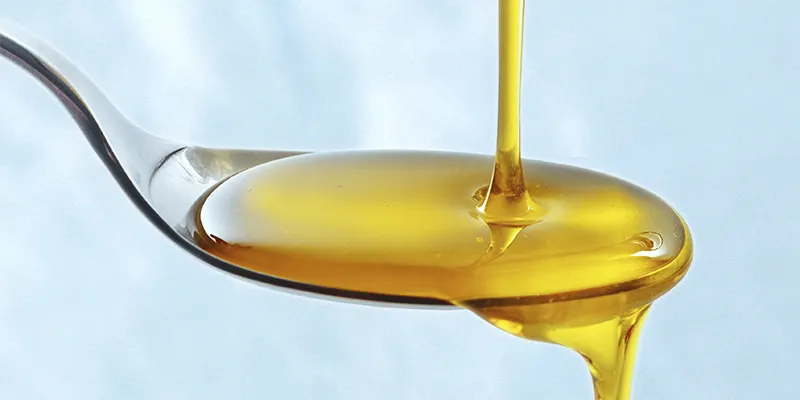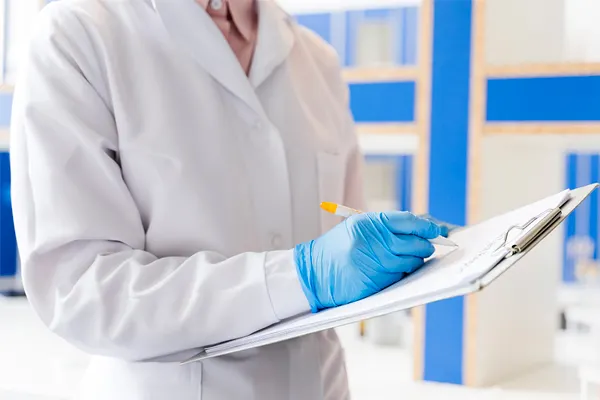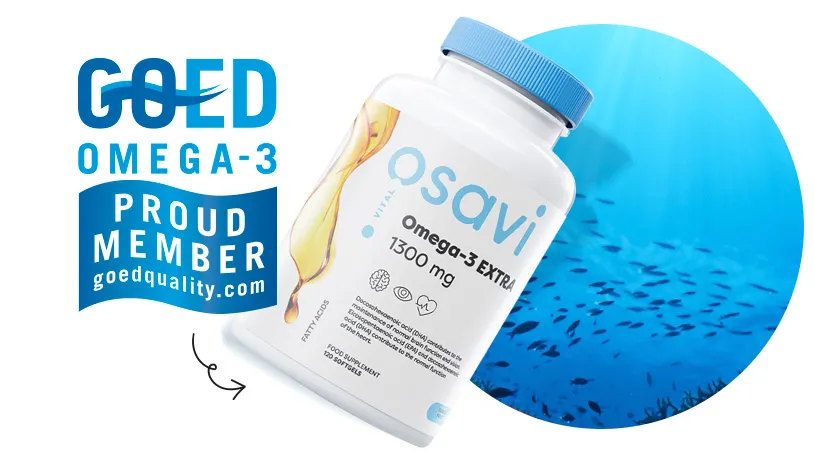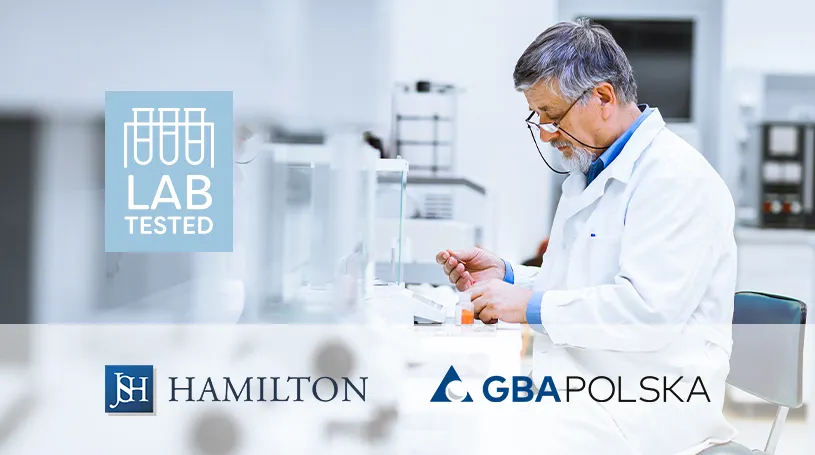
How to know the quality of omega-3 oil? Check the TOTOX index!
Not sure if the omega-3 product you bought is fresh? Check the TOTOX indicator and see for yourself the quality of the oil.
Awareness about taking omega-3 fatty acids is still growing and more and more people are realising how important they are for the proper functioning of the body. Unfortunately, determining which product is of high quality is often quite problematic for the average consumer. It is worth knowing that not only the specific content of DHA and EPA or the study of environmental pollution is an indicator of the safety and effectiveness of using fish oil. The TOTOX indicator - although it may sound quite puzzling to many - is an important piece of information that allows you to determine the quality of the oil.
It is calculated on the basis of the measurement of anisidine and peroxide numbers, and global organisations have defined the maximum value of this indicator for fish oils. OSAVI dietary supplements meet the highest standards in this regard, which is confirmed by the results of independent tests carried out in an accredited laboratory.
What should you pay attention to when choosing fish oil? TOTOX indicator - what is it and why it is worth knowing what it means?
The TOTOX index is a number indicating the total degree of oxidation of the oil. In order to determine its value, the anisidine number (AV) and peroxide number (PV) should be measured, i.e. the amount of secondary and primary oxidation products in oils [1]. World organisations - e.g. Global Organization for EPA and DHA Omega-3 (GOED), Food and Agriculture Organization of the United Nations (FAO) and World Health Organisation (WHO) - set quality limits determining the allowable amount of oxidation products and the maximum value TOTOX for these oils. Thanks to the standards set by these institutions, the consumer is guaranteed to reach for the highest quality fish oils.
But what does the TOTOX indicator tell the average customer? Simply that the lower its value, the higher the quality of the oil. It provides information about the lower content of oxidation products (oxidation is the main cause of lowering the quality of fats). Many factors affect the speed of this process, such as:
- Composition of fatty acids (unsaturated fatty acids are susceptible to oxidation, which is why it is so important that products containing omega-3 fatty acids were produced in an inert gas atmosphere, i.e. without access to oxygen, which favours this unfavourable process).
- The presence of antioxidants (substances that protect against potential oxidation).
- Storage conditions (access to oxygen, temperature, access to light).
Considering the above conditions, it is worth remembering to choose products from omega-3 in dark glass (e.g. in liquid forms) or in non-transparent packaging (e.g.g.capsules and soft). To maintain their high quality, after opening, they should be stored in appropriate conditions - in a cool place, in sealed packages and protected against access to light and air [2, 3].

Global standards for the quality of fish oils. Which institutions are at the forefront of setting general standards?
There are worldwide guidelines for quality of fish oils established by regulatory authorities to prevent non-compliant products from entering the market. The most important are:
- Codex Alimentarius, which is a set of food standards and codes of practice adopted at the international level by Codex Alimentarius Commission (CAC). This commission was established in 1963 as part of the Joint FAO/WHO Food Standards Program, which was created by FAO (Food and Agriculture Organization of the United Nations) and WHO (World Health Organization).
The purpose of the Code is to protect the health of consumers and ensure fair practices in food trading, and also guiding and promoting the development and establishment of definitions and requirements for food to help harmonise them and thus facilitate international trade [4]. - GOED Voluntary Monograph – the standards contained therein are an indicator of quality omega-3 in the global industry. The standard has been developed to ensure that the oils reaching consumers are both safe and of high quality. The companies and organisations that participated in the development of the monograph have applied the strictest standards of quality and purity - which means that any oil produced according to the monograph's standards can be sold worldwide.
Above voluntary quality limits have been set by oil producers and retailers through Global Organization for EPA and DHA Omega-3 (GOED) [5, 6].
Mention should also be made of EFSA, that is the European Food Safety Authority, which provides information and offers independent scientific advice on food hazards.
Though there are no clear regulatory guidelines for limits TOTOX for fish oils issued by EFSA, the scientific opinion submitted by the committee in 2010 provides an assessment of their quality. This document reads:
„Currently, peroxide and anisidine methods are the most reliable chemical methods for measuring rancidity in fish oils. Current knowledge does not allow setting and recommending maximum peroxide and anisidine limits for the many different refined fish oils.”
The document shows how important these parameters are and confirms the standards set by GOED and WHO. However, EFSA did not undertake to present limits separate from those applicable worldwide [7, 8]. In the detailed description, there are examples of quality parameters - e.g. raw fish oil or fish concentrates - mainly on the basis of the available literature, which are for illustrative purposes and in no way constitute EFSA guidelines in the legal sense.
In addition, in the section on the Goed Manufacturing Practice guidelines, EFSA refers, for example, to the GOED organisation, and in the part devoted to the quality guidelines for fish oils - to Pharmacopeia USP GOED and CRN (Council for Responsible Nutrition), which cooperates with the GOED organisation and with their participation, the GOED Monograph was created [7, 9].
Codex Alimentarius Monograph GOED are among the most important regulatory documents that do more than just define quality standards for fish oils but also a point of reference for other food and consumer health organisations. These standards are respected all over the world by the largest manufacturing tycoons, fish oils.

How to find the best quality omega-3 product? Tested OSAVI supplements are a safe choice
Are the supplements with omega-3 you choose been thoroughly tested? In OSAVI we make every effort to ensure that our products meet the standards for fish oils -the highest quality is our priority.
It is determined for each product series index TOTOX, which is the most important indicator to determine the quality of fish oil. Taking into account the standards set by global organisations, we have defined the following fish oils limits for individual parameters. Here you can mention, among others:
- The peroxide value, for which the required value is ≤ 5 meq/kg.
- The anisidine number, for which the required value is ≤ 20.
- TOTOX indicator which should be ≤ 26.
Each batch of product is tested in an independent, accredited laboratory, thanks to which the consumer is guaranteed not only the high quality of our products, but also the safety of their use. Supplements meet all requirements for purity and composition – The purity of our products is controlled by testing environmental contaminants such as dioxins, dioxin-like PCBs, polycyclic aromatic hydrocarbons (PAHs) and heavy metals. We also test the content of omega-3 fatty acids, e.g. eicosapentaenoic acid (EPA) and docosahexaenoic acid (DHA).

Fish oils used in OSAVI products meet the highest standards recognised by international institutions, including:
- FOS (Friend of the Sea) – Friend of the Sea certification guarantees the quality of fish products, and contributes to the promotion of sustainable fishing and farming [10].
- IFOS (International Fish Oil Standards) – IFOS enables companies to test their products to the highest global standards of quality, safety and purity; IFOS is a member of GOED, which is confirmed by the value of the certificate [11].
- WHO – World Health Organisation together with FAO, set up a Commission: Codex Alimentarius Commission which they accepted Codex Alimentarius (one of the most important documents defining quality standards for fish oils).
We are also part of the GOED - World EPA and DHA Omega-3 Organization and as a member we fully respect its GOED monograph setting the strictest standards of quality and purity for products containing omega-3 fatty acids. This allows us to build awareness about these acids, and by providing them in the best quality - also to encourage their intake.
Global Organization of EPA and DHA omega-3 founded in 2006 in the United States, whose mission is to increase acid intake omega-3 EPA and DHA (https://goedomega3.com/), published a monograph in which it defines high quality standards of oils. Members of the organisation are required to strictly adhere to these standards. Thus, consumers buying products with the logo GOED have a guarantee that they are manufactured in accordance with the principles of quality and ethics summarised in the publication [5].
Food supplements OSAVI are tested for freshness, impurities and acid content omega-3. They meet the highest standards in this regard, which is confirmed by the results of independent tests carried out in an accredited laboratory. We additionally confirm the quality of our products Certificate of Analysis made available to our customers [12].
[1] Wroniak, M., Kwiatkowska, M., & Krygier, K. (2006). Charakterystyka wybranych olejów tłoczonych na zimno. Żywność Nauka Technologia Jakość, 13(2), 46-58.
[2] Termiczna trwałość kwasów omega-3. Medycyna Praktyczna. Pobrano 18.01.2023 z https://www.mp.pl/pacjent/dieta/lista/64142,termiczna-trwalosc-kwasow-omega-3.
[3] Jak przechowywać tłuszcze? Polska federacja producentów żywności związek pracodawców (PFPŻ ZP). Pobrano 18.01.2023 z http://dobretluszcze.pl/jak-przechowywac-tluszcze/.
[4] About Codex Alimentarius, Codex Alimentarius. International Food Standards. Pobrano 13.01.2023 z https://www.fao.org/fao-who-codexalimentarius/en/.
[5]GOED | The global organization for EPA & DHA omega-3s, Pobrano 13.01.2023 z https://goedomega3.com/.
[6] The GOED Voluntary Monograph, GOED | The global organization for EPA & DHA omega-3s, Pobrano 13.01.2023 z https://goedomega3.com/goed-monograph.
[7] EFSA Panel on Biological Hazards (BIOHAZ); Scientific Opinion on Fish Oil for Human Consumption. Food Hygiene, including Rancidity. EFSA Journal 2010; 8( 10):1874. [48 pp.] doi:10.2903/j.efsa.2010.1874.
[8] European Food Safety Authority (EFSA), European Union gateway, Pobrano 13.01.2023 z https://european-union.europa.eu/institutions-law-budget/institutions-and-bodies/institutions-and-bodies-profiles/efsa_en
[9] About CRN, Council for Responsible Nutrition. Pobrano 13.01.2023 z https://www.crnusa.org/about-crn#.
[10] Friend of the Sea – Certification for Sustainable Seafood, Fisheries and Aquaculture Products, Certified Sustainable Seafood | Omega 3 | Aquaculture Services. Pobrano 13.01.2023 z https://friendofthesea.org/friend-of-the-sea/.
[11] What is IFOS? Certification for Nutrasource. Pobrano 13.01.2023 z https://certifications.nutrasource.ca/about/how-certifications-work/ifos. [12] Jakość, Osavi. Pobrano 13.01.2023 z https://osavi.com/pl/jakosc.




